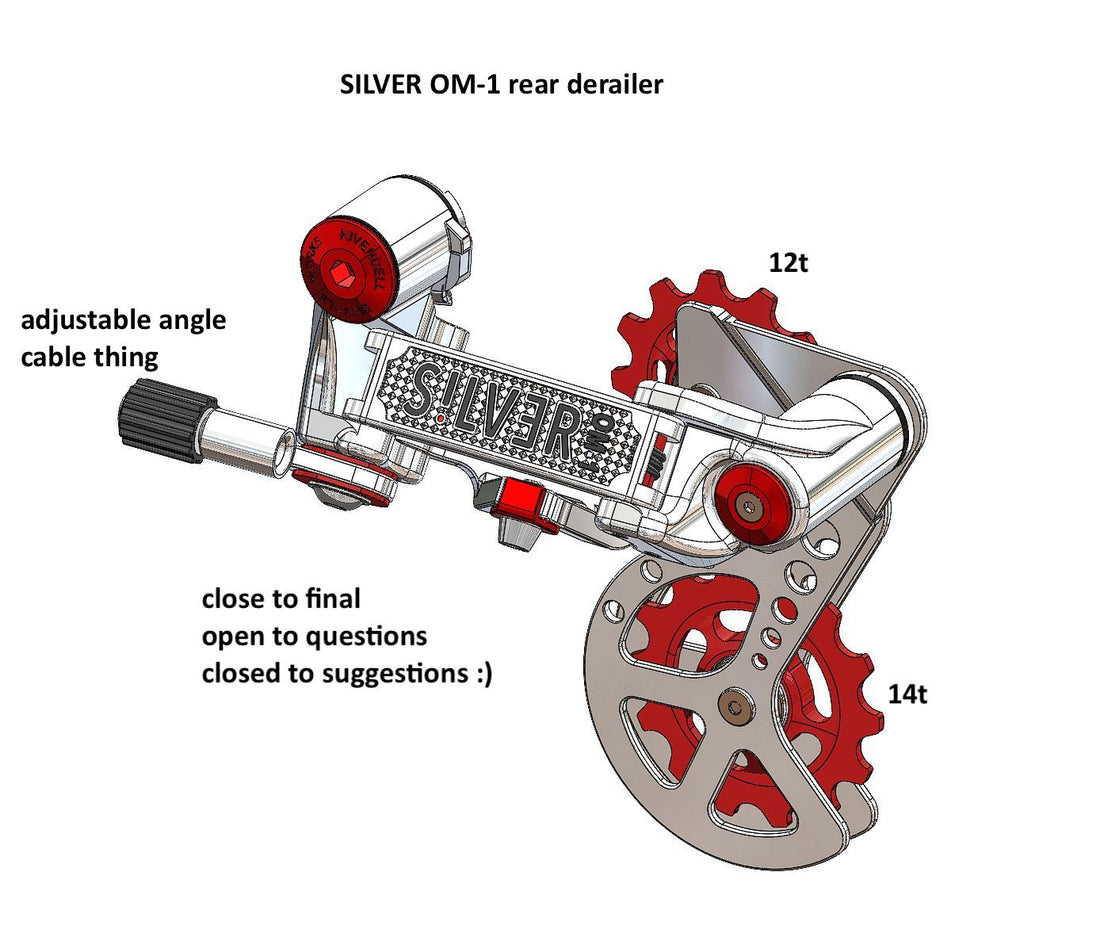
OM-1 Rear Derailer Update
Share
- OM stands for Opposite Movement. It’s a “low-normal” derailer, meaning that when the spring is relaxed, the derailer pulleys are under the big cog, the low-gear. To shift to higher gears, you have to pull against/stretch the spring. This is the opposite of the way all other modern (“high-normal”) derailers are made—but it is not the fruit of Rivendell’s nonexistent Genius.
Low-normal derailers were common in the 1950s. The first super-duper, revolutionary slant-parallelogram 1964 SunTour Gran-Prix derailer was low-normal. IT MAKES MORE SENSE, but SunTour had zero clout and influence back then, and when Campagnolo introduced its Gran Sport derailer in 1960, that everybody who was a cool pro used that. Simplex copied it. Huret copied the same high-normal movement, and SunTour (and Shimano) were those little-known Japanese makers that were still finding their way in the world.
SunTour derailers were first exported in the early 1970s. Maybe 1970 itself. That was the year of the Bike Boom, and European derailer-makers couldn’t supply the surge. After a while, several years, it became apparent that SunTour derailers, with the magical slant-parallelogram feature that kept the top pulley close to the cogs throughout its outward-inward path, was shifting magic. When the patent ran out in 1984, Shimano hopped on it, and must have been planning, because they had their own slant-parallelogram derailers in 1985.
SunTour, for a variety of reasons related to indexed shifting that didn’t work as well as Shimano’s, fell on hard times and eventually quit. The name was bought, you can see it on inexpensive suspension forks, but the Good Old SunTour was gone by the mid-1990s. They’re not coming back, ever, so don’t even hope.
In 2000 (plus or minus a year) Shimano, who was on top of the derailer world by then, introduced its own low-normal derailers, which it called RapidRise. They were made only for mountain, not road—the ideas being that (1) the low-normal advantage of spring-assist to get the low gears NOW was more of a help to trail riders and tourists than it was to road racers; and (2) Road racers and their followers were more tradition-bound, and less likely to try something different.
But even Shimano was nervous about introducting RapidRise. They believed in it, pushed it, but offered it as a parallel option to its high-normal derailers. Bike manufacturers had the option of low-normal or high-normal derailers of the same grade (Deore, LX, XT, XTR). The big bike makers were too chicken to go whole-hog RapidRise; a few bikes had them, and most bike shop mechanics hated learning knew tricks in setting them up (it’s no harder, it’s just different). Mountain bike racers didn’t want to shift the wrong way in a race. The whole RapidRise movement lasted four years, ending in 2004/5, and Shimano must have been frustrated, because mechanically, logically, intuitively, low-normal/RapidRise derailers are better…for reasons not going into here.
We’ve bought ever one we could buy, off eBay and from distributors and other sources. We have seventy left. I/Grant have them on four of my six bikes, and I have no problem switching back and forth. Sometimes I shift to a high gear when I need a low gear, so what? I did that when all my bikes were high-normal, too. Just normal, inconsequential micro-flubs, easily and instantly corrected. Reminders that I’m riding an honest mechanical bicycle that doesn’t care who you are, it’s going to act honestly no matter what.
On InstaGram, every time we show an image of the OM-1 derailer, somebody will comment that too bad it’s like RapidRise; that they’d like it otherwise. But RapidRise is the whole point. We’re not going to make a derailer that’s just another high-normal. ShimanoSRAMCampy already do that. We’d have nothing to contribute except maybe a different look, and that’s not enough, that’s not worth 3+ years of development time. That would be stupid and pointless.
So low-normal it shall be! We’re not calling it RapidRise, because that’s Shimano’s name for it, and this isn’t a Shimano derailer. We could refer to it as “low-normal,” but that’s a confusing term to most riders. We’re going with OM-1, for Opposite Movement, and the -1 means it’s the first version. Maybe we’ll do a second, we just don’t know. Plus, the Olympus OM-1 camera is a favorite. The use of “OM-1” in the derailer doesn’t brake any trademark laws, because nobody is going to assume that Olympus is now making derailers or that Rivendell is now making cameras. There are “OM” other things out in the market. Even “OM-1” other things.
Made in China. We asked SunRace and microSHIFT to make it for us, no dice. It was pandemic time and the couldn’t spare factory time for this loser-of-an-idea. So we searched China. Sensah, comprised of people who used to make SRAM derailers, didn’t want to do that. They didn’t say so outright, but after working with them (thru an intermediary) for most of a year—and getting one prototype that worked great—they said they’d make us a trial run of fifty for $350 each. That’s one way to say NO! in Chinese.
Now we have another place, a guy who came highly recommended, a guy who knows bike parts, engineering, manufacturing, sourcing, and assembly. He’s our guy. The quote is reasonable but not final.
The design/engineering/heavy lifting on this side of the world has been done by a guy, a friend, an engineer and cad guy in his 60s who has a long and deep history in the bicycle industry (custom builder, co-founder of a bike painting business, long since sold but still thriving) and other industries—including dental and fly-fishing. His name is Dan Falvey. He knows more about Shimano derailers than any American in the world, and more about the guts of them than anybody not currently employed as a rear derailer engineer at Shimano.
It’s possible that something will prevent this derailer from happening, but our confidence level —after vacillating between 25 and 45 percent for most of the last three years, is now at 80 percent. If this derailer happens, it’ll be within a year. We don’t know the price, but we will respect the time and expense we’ve put into it, and $175 + seems reasonable, based on our estimated cost…which isn’t final.
The red in the images are “just for now,” and won’t be final.
